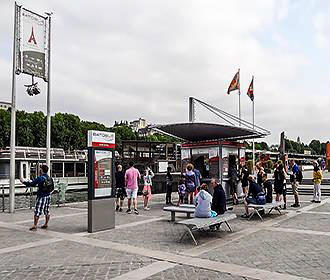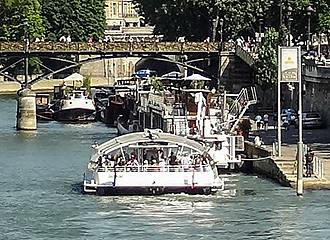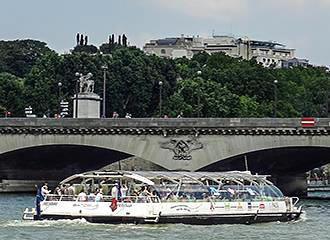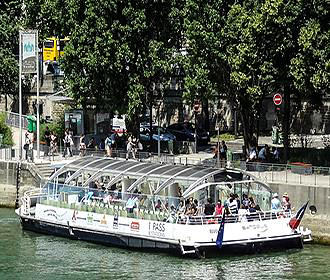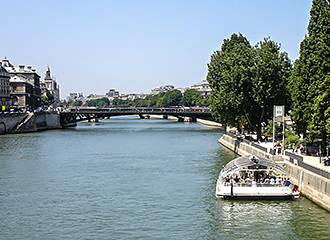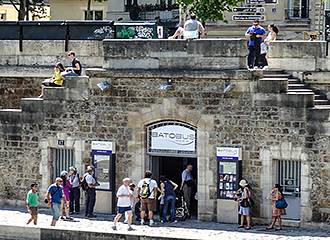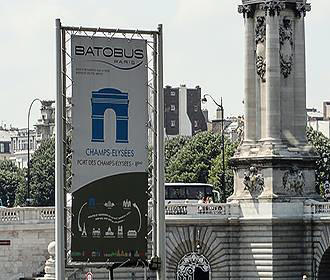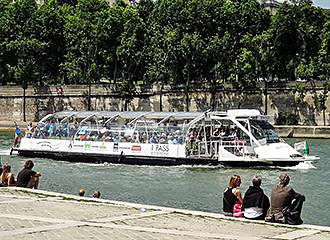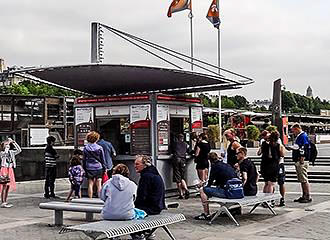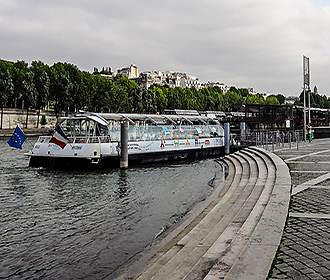Paris Batobus stops on the River Seine
The Paris Batobus is a water bus service, which is a very different kind of Paris public transport and is designed to enable people that are on holiday in Paris to reach many of the monuments, landmarks and different Paris tourist attractions.
The Paris Batobus stops on the River Seine
There are actually six Paris Batobus stops on the Left bank of the River Seine, which in order as you go round are the Eiffel Tower, Invalides / Pont Alexandre III, Musee d'Orsay, Saint-Germain-de-Pres, Notre Dame Cathedral and then Jardin des Plantes.
In addition to these there are also three Paris Batobus stops on the Right Bank of the River seine, which again in order are the Hotel de Ville, the Louvre Museum and the Concorde stops, before the glass covered boats go back round the most famous Paris monument, which is of course the Eiffel tower.
Yet the Batobus Paris water bus service runs in a circuit and does not zig-zag across the river, you just have to wait until the Paris Batobus reaches the stop on its circuit, but to following is a taste of just some of the Paris tourist attractions, monuments and Paris landmarks that you could discover within walking distance of each of the Paris Batobus stop on the River Seine along with how to get to each Batobus docking station.
The Eiffel Tower Batobus stop
The most famous of all landmarks in France is of course the Eiffel Tower with its incredible illuminations, which is opposite the Trocadero Gardens, and is located within the Champs de Mars that was the former military drill ground of the Ecole Militaire.
However, a good view point of the monument is from the Palais de Chaillot that has several museums and a theatre, yet there are also several other tourist attractions within easy reach of this Paris Batobus stop on the River Seine including the Musee du Quai Branly, the CineAqua Paris Aquarium and the Musee du Vin. Plus, you have the unusual Paris sewers museum called the Musee des Egouts along with the Maison de la Culture du Japon for something entirely different.
Accessing the Eiffel Tower Batobus Stop
Located in the 7th Arrondissement of Paris, the Port de la Bourdonnais is at the foot of the Eiffel Tower opposite the Trocadero Gardens, so you just need to cross the street called the Quai Branly and walk down the stairs at the right hand corner of the Pont de Iena and you will see the Batobus Tour Eiffel docking station.
This particular Paris Batobus stop on the River Seine is in fact the main departure and terminus point for the Batobus, where you can also purchase tickets or collect them if you have ordered online. There is also a ramp that can take you down to the quay for those with wheelchairs or pushchairs, even though this can also be used by vehicles, but at this point we would like to mention that the Tour Eiffel stop is the only water bus station with disabled access.
The Invalides / Pont Alexandre III Batobus Stop
Les Invalides is a major complex and an impressive monument that was constructed in the 1600s under the orders of King Louis XIV and today holds many canons, museums and the Tomb of Napoleon Bonaparte, yet there is also another popular museum right by here called the Musee Rodin.
Other popular tourist attractions within walking distance of this Paris Batobus stop on the River Seine include the most ornate bridge, the Pont Alexandre III, along with the Grand Palais and Petit Palais, all of which were constructed for the 1900 Paris World Fair.
Accessing the Invalides / Pont Alexandre III Batobus Stop
Also within the 7th Arrondissement of Paris, the address for this Batobus stop is Port des Invalides and when you are at the Pont Alexander III bridge on the side of Les Invalides by the Quai d'Orsay, you would need to go down the right hand side set of steps to the quay. From the quay, continue walking away from the bridge for approximately 100m and then you will end up at the Batobus stop and docking station.
The Musee d'Orsay Batobus stop
This Paris Batobus stop is located by an old railway station, and when looking at the history of the Musee d'Orsay, you will find this area of Paris was originally an upmarket and aristocratic neighbourhood, yet the old railway station was eventually used for many purposes, in time being turned into the Musee d'Orsay museum in Paris, which starts its impressive collections from where the Louvre museum stops.
A secretive area of Paris where you can admire fabulous old mansions with many now utilised by Foreign Embassies and diplomats, you could also visit tourist attractions such as the Musee Maillol, Musee National de la Legion d'Honneur, see the Thomas Jefferson monument and admire the unusual Leopold Sedar Senghor footbridge over the River Seine, which will get you to the historical Tuileries Gardens.
Access to the Musee d'Orsay Batobus Stop
To access the Musee d'Orsay Batobus stop, as you leave this museum and are on its parvis, or square, decorated with statues, then you would cross the street called Quai Anatole France in the direction of the River Seine. Go down the steps to the river bank and walk a few steps to your right, so that you are below the main facade of the historical railway station, and here you will find the Quai de Solferino where the water bus docking station is located, also in the 7th Arrondissement of Paris.
The Saint-Germain-des-Pres Batobus Stop
The abbots were the first people to settle in this area of Paris and they brought with them money and knowledge and then the Academie Francaise or French academy for literature, art, etc was formed along with the Ecole des Beaux Arts art school. Therefore Saint-Germain-des-Pres has always been regarded as a place for literature, art and philosophy and there are numerous bookshops and galleries.
However, there is much more to this popular area of Paris, such as the old apartment and studio of an artist, the Musee Eugene Delacroix, the Saint Sulpice church, Musee Cluny also known as the Musee du Moyen-Age, and Bibliotheque Mazarine, which is the oldest French public library. There are also many different historic quays, with the oldest called the Quai des Grands-Augustins dating back to the early 1300s plus famous River Seine bridges like the Pont des Arts.
Access to the Saint-Germain-des-Pres Batobus Stop
The Saint-Germain-des-Pres Batobus stop is at the Quai Malaquais, which is close to the Institute de France in the 6th Arrondissement of Paris and by following the Rue Bonaparte you will reach the quay. You just have to cross the road and go down the steps to the river bank in order to access this particular water bus stop.
This Paris Batobus stop on the River Seine is right by the Balle au Bond entertainment barge at the Porte des Saints-Peres, however, we would like to point out that if the ticket office is closed, then you would need to go to the next station, which is the Batobus Notre Dame stop.
The Notre Dame Cathedral Batobus Stop
The Ile de la Cite is the very heart of historical Paris and is an island in the middle of the River Seine, which is where Paris was first founded and the original name was Lutitia. It became the official Kings residence and La Conciergerie, which was a palace, that was then turned into a prison where Marie Antoinette was held, is just one of the places you can visit.
Just along the River Seine there was a port that once brought the firewood to the city and even today, the Ile de la Cite can only be reached either by boat, or one of the bridges like the Pont Neuf, which is actually the oldest bridge across the River Seine.
However, on this island there is also much more to see such as the Saint Chapelle chapel and the impressive Notre Dame Cathedral, which is also known as the Notre Dame de Paris Cathedral, yet opposite on the Left bank you have tourist attractions like the Fontaine Saint-Michel, the Caveau de la Huchette Jazz Club, Salvador Dali sundial and many others.
Access to the Notre Dame Batobus Stop
The Notre Dame Batobus stop itself is on the opposite bank to the Ile de la Cite and faces the Notre Dame Cathedral where it is located in the Latin Quarter of the 5th Arrondissement of Paris, and the nearest bridge to access these monuments in Paris plus the water bus stop is called the Pont au Double.
So, to access this Paris Batobus stop on the River Seine, you would need to go to the Quai de Montebello and walk around 100m upstream from the Pont au Double, in other words, as though going to your right if facing the River Seine, then you take the stairs down to the river and the quay.
Jardin des Plantes / Cite de la Mode et du Design Batobus Stop
Incredibly, this stop used to be a beach for people to wash in until bathing in the River Seine was forbidden and the first baths were opened towards the end of the 1600s. Since then, the area has been home to many warehouses and there were trade ports constructed plus there was a large herb garden constructed and then a natural history museum was starting to get established.
Today, you can still get to see the botanical gardens of the Jardin des Plantes along with four museums and a small zoo not forgetting the Cite de la Mode et du Design, also known as Les Docks with its restaurants, night club, and many events around fashion and design. Plus, nearby is the Grande Mosque and the Institut du Monde Arab, along with the Musee de la Sculpture en Plein Air open air sculpture museum.
Access to the Jardin des Plantes Batobus Stop
The Batobus water bus service then stops at the Quai Saint-Bernard, which is located in the 5th Arrondissement of Paris between the Pont Sully and the Pont d'Austerlitz, which is also where the open air sculpture museum is located.
One way of getting this Paris Batobus stop on the River Seine is by taking Rue des Fosses-Saint-Bernard towards the River Seine, then cross Quai Saint-Bernard, which is in front of the Institut du Monde Arabe and go down to the river via the ramp or the stairs.
From there you would need to walk upstream towards Pont d'Austerlitz and through the Jardin Tino Rossi, which is the beautiful open air sculpture garden. However, if the ticket office is closed, you would need to go to the Hotel de Ville Batobus stop on the opposite bank of the River Seine.
Hotel de Ville (Paris City Hall) Batobus Stop
At the Hotel de Ville Batobus stop, which is also known as the Paris City Hall Batobus stop, you will be able to discover old houses looking out onto cobbled streets from days gone by, within the Saint-Paul and Saint-Gervais areas along with the impressive Renaissance style Hotel de Ville.
Also located within the 4th Arrondissement of Paris in the Marais district you will be able to discover the Pompidou Centre, or Beaubourg that holds the Musee National d'Art Moderne. Then there is the Institut Tessin, the Bel Canto opera performance restaurant, Musee Picasso and the lively Jewish quarter with many different boutiques and eclectic bars, etc, not forgetting the Ile Saint-Louis island as well.
Access to the Hotel de Ville Batobus Stop
To reach the Batobus water bus from this area, when you are in the Place de l'Hotel de Ville located in front of the Paris City Hall, you would take the pedestrian underpass to the Quai de l'Hotel de Ville.
Then walk upstream along the quay for around 100m, which is in the direction of the Ile Saint-Louis and the Pont Louis Philippe, or to your left as though you are looking at the River Seine, where you will find the Batobus docking station on the Quai de l'Hotel de Ville on the river bank below the Voie Georges Pompidou.
The Louvre Batobus Stop
Located in the 1st Arrondissement of Paris, back in the early part of the 1800s, the port at The Louvre saw the arrival of the first steamboat called the Elise, which was watched by hundreds of people. Yet today, it is this area that has become more popular because of visiting the most famous Paris museum and the most well renowned art museum in the world called the Musee du Louvre.
However, there are also many other museums located nearby, such as the Musee des Arts Decoratifs, the l'Orangerie and the Jeu de Paume within the Jardin des Tuileries, not forgetting cafes and restaurants like Angelina or others in the gardens for a relaxing snack. Plus, there is the Arc de Triomphe du Carrousel, which is one of the Paris monuments that was constructed for Napoleon Bonaparte I, along with many luxury boutiques, and antique shops to browse including Louvre des Antiquaires.
Access to the Louvre Batobus Stop
The Quai du Louvre is located between the Pont Royal and the Pont du Carrousel bridges, and if you think about walking from the Musee du Louvre towards the quays on the River Seine, you would then turn right and walk for around 100m, which is just before you would cross the Pont du Carrousel.
It is here in the 1st Arrondissement of Paris that you will find the steps leading down to the quay where you continue walking to the right as though you are looking at the river, and this is where you will find the Batobus Louvre Station on Quai du Louvre.
Place de la Concorde / Champs Elysees Batobus Stop
The most famous Avenue in the World is the Champs-Elysees, which translates to Elysian Fields in Greek, and is one of the well-known tourist attractions and landmarks in Paris that has a rich history and is a beautiful tree lined avenue.
The Avenue des Champs-Elysees runs from the Place de la Concorde with the Luxor Obelisk, up to the Place Charles de Gaulle with the fabulous Arc de Triomphe, which was the triumphal arch commissioned by Napoleon Bonaparte I and now home to the Tomb of the Unknown Soldier with its eternal flame, and hence why this Paris Batobus stop on the River Seine is known as the Place de la Concorde / Champs Elysees stop.
This avenue has become a place to shop and eat out in Paris, yet it is also the setting for major street parades, military parades and ceremonies, like those related to the French Revolution on the French National Holiday of 14th July each year.
Disembarking at the Champs Elysees stop, you could also visit the Champs Elysees Gardens with its fountains, the Theatre Marigny and top table restaurants, the Avenue Montaigne that is home to numerous high-end boutiques such Louis Vuitton, Dior, Chanel etc. Plus, you could visit the Grand Palais, or the Petit Palais that is home to the Musee des Beaux Arts de la Ville, not forgetting walking up from the Place de la Concorde to Maxim's museum, and Place de la Madeleine with its church and famous shops like Fauchon.
Access to the Place de la Concorde Batobus Stop
Located in the 8th Arrondissement of Paris close to the Pont Alexandre III bridge, if you are coming from the Place Clemenceau, you would need to take the Avenue Winston Churchill heading towards the River Seine. Then you would make your way downstairs, which are situated to the left of the Pont Alexandre III in order to find this particular Paris Batobus stop on the River Seine.
And although the Batobus docking station is located on the Porte des Champs-Elysees, it is also right by where it changes to the Porte de la Concorde, so you can also access quay for boarding by the Place de la Concorde and turn to your right when looking at the River Seine taking a nice stroll along the quay.
Batobus water bus maps, timetables and ticket prices available:
BatoBus Map, Timetables and Prices - PDF
BatoBus Map, Timetables and Prices - Image
From this last Paris Batobus stop on the River Seine, the trimaran Batobus boats then go back to the terminus and main departure point of the Eiffel Tower stop, with a complete round trip taking approximately 1 hour 40 minutes. There is an approximate journey time in between each Batobus stop of between around 8 minutes up to around 17 minutes, as you will see from the Batobus map.
So as you can imagine, with all these different Paris Batobus stops on the River Seine this form of transport in Paris has also become very popular with the locals, as well as a great way for visitors or tourists to see this remarkable city in a more relaxed and unusual way compared to some other transport options, not forgetting that this is a hop on and hop off service.
